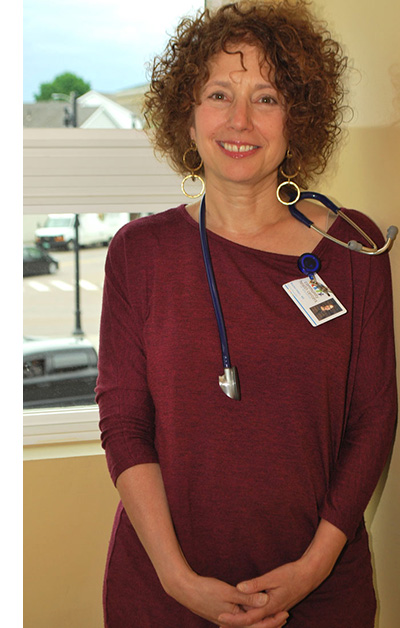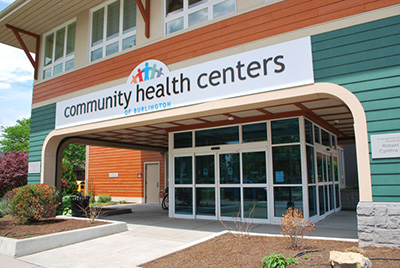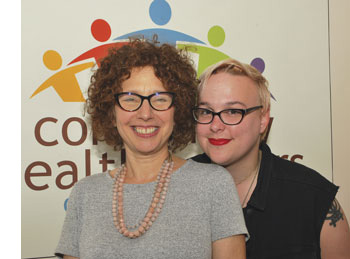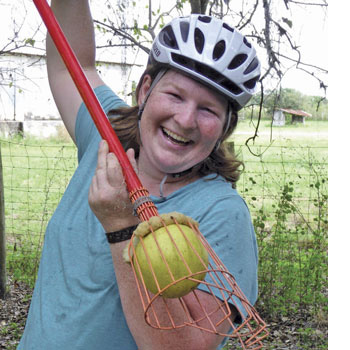Jamie Moorby, who grew up in rural Vermont and still lives there, “always knew [she] was a woman inside.” But she didn’t know about the possibility of gender transition until she was in college. A “happy person who wasn’t stressed out” by a growing awareness that she might want to transition, she moved to Washington, DC, after graduation to work as a political activist. There she found community, a transgender activist group, and helpful resources while working on a bathroom bill that now prohibits single-stall bathrooms to be gender specific. |

Dr. Rachel Inker is a primary care provider at the Community Health Center in Burlington. photos: Jan Doerler |
 |
She soon realized that she did want to transition, so she saw a therapist and then a physician, went on hormones, and two years later, in 2008, at the age of 26, flew to Bangkok with her supportive mother for surgery. “The culture there was amazing,” she recalls. “There were trans women from all over the world. It was a very communal experience.” |
Jamie Moorby, who grew up in rural Vermont and still lives there, “always knew [she] was a woman inside.” But she didn’t know about the possibility of gender transition until she was in college. A “happy person who wasn’t stressed out” by a growing awareness that she might want to transition, she moved to Washington, DC, after graduation to work as a political activist. There she found community, a transgender activist group, and helpful resources while working on a bathroom bill that now prohibits single-stall bathrooms to be gender specific.
She soon realized that she did want to transition, so she saw a therapist and then a physician, went on hormones, and two years later, in 2008, at the age of 26, flew to Bangkok with her supportive mother for surgery. “The culture there was amazing,” she recalls. “There were trans women from all over the world. It was a very communal experience.”
But when she returned to Vermont, she says, while her friends and family were supportive, the medical professionals she met with were “very confused,” and she couldn’t find a doctor who would do a postoperative examination. Enter Rachel Inker, MD, to whom Moorby was referred by a Montpelier advocacy group in 2010 because “she knew how to deal with hormones.”
A Call to Relieve Suffering
Rachel Inker’s background has prepared her for working with people who struggle to access appropriate health care. An English major who graduated from Harvard in 1986, she wanted to travel, work, and explore the world, so she bought an around-the-world air ticket and spent eight months traveling in Europe and Asia, often alone. She spent five months in India, two of them working as a volunteer with an English doctor, whom she describes as “extraordinary,” in the street clinic he ran for Bangladeshi refugees. She also worked as a volunteer at a hospice run by Mother Theresa.
“I’d always thought about being a doctor, but this was the first time I’d met people for whom helping to relieve suffering was a calling, and it made a tremendous impression on me,” she says.
She went on to spend several years working in therapeutic outdoor and residential programs in New England and in several western states. “Working with struggling teenagers in the wilderness remains some of the best work I’ve done,” Inker recalls. “There is nothing more therapeutic than being outdoors, working as a team, and having to meet whatever challenges present themselves.” She hopes to do this kind of work again.
At the age of 30, Inker entered medical school in her home state and graduated in 1998 from the University of Massachusetts in Worcester. During her first year there, in 1994, she met Chris Brown, an architect and furniture maker, through a classmate who was dating his brother. They married when she graduated and moved to Burlington, Vermont, where she started her family practice residency at UVM. They have three children, twin 16-year-old girls and a 12-year-old son.
“Medical school and then residency was an incredible and demanding period of learning, challenge and growth,” Inker recalls. “Family medicine allowed me to provide care for people of all ages and also to use my experiences working in mental health.”
“I’ve always been moved and fascinated by people’s unique stories and experiences,” she adds. “From the time I was a kid, I enjoyed casual ‘interviews’ and began to appreciate how people lived very different lives than my own,” says the daughter of a lawyer and a social worker.
Board-certified in family medicine, Inker has been a family physician at the Community Health Centers of Burlington since 2001. She continues to be a per diem provider at UVM’s Urgent Care clinic and is a clinical instructor at UVM medical school.
Inker, a family practice physician, first learned about gender transition in 2004 working at the Community Health Centers of Burlington as a family practice physician. There she heard a presentation on trans men and women by a transgender educator. After the talk, the presenter invited anyone interested in transgender health care to be in touch since no one was providing care locally. Inker had no formal training in caring for transgender patients so she began researching existing protocols and networking with other providers locally and across the US. Many of these providers had begun serving transgender patients because of a growing grassroots movement that had taken hold in community health centers in large cities. Today, Dr. Inker is the lead medical provider at the Transgender Clinic affiliated with the Community Health Center of Burlington.
“There has been a big cultural shift,” she says. “There’s been more visibility and social acceptance over the past several years for gender transition, in large part due to well-known people transitioning publicly. There has also been improved insurance coverage, more access to care, and more providers willing to offer care.”
Prior to this cultural shift, Inker was one of few medical providers in Vermont providing the option of hormonal transition and trans-affirmative care to transgender Vermonters. Over the past few years there has been an increase in the number of providers offering this care, including college health centers, primary care providers, and Planned Parenthoods throughout Vermont and the region. “There is less isolation because of the Internet leading to more online support and information for people and their families,” Inker says. She also describes better insurance coverage in Vermont. In 2013, the state passed an insurance bulletin based on previous antidiscrimination legislation that mandates, like multiple other states, that transgender Vermonters have coverage for transgender care. |
 |
All of this is not to say, as Inker points out, “that there isn’t room for improvement, but overall the trend locally is very positive.” But she quickly adds, “I’m in a little bubble here [in Burlington] where people have improved insurance coverage and more community acceptance. There are still real and painful experiences of hate and discrimination for transgender men and women every day. It takes an enormous amount of courage to transition.”
Continuing Medical Issues
Nationally, many big issues remain in caring for transgender individuals, estimated in 2011 to constitute about 0.3 percent of the US population (about 700,000) in an analysis of several sources carried out at the UCLA School of Law. The analysis showed that a majority of people who identify as transgender have taken some steps to transition from one gender to another.
Among the most pressing health-care issues for transgender people remains the inability to access care. A 2010 survey conducted by the National Center for Transgender Equality and the National Gay and Lesbian Task Force found a significant number of respondents had been refused care due to their gender status, especially among people of color. An even higher percentage reported being harassed in a medical setting, and half of the respondents said they had to teach their providers about transgender care.
This study, like many others, is now dated, but the issues it raises are still present. Both Dr. Inker and Jamie Moorby speak to the need for more and better training. While there is now training in various curricula at UVM and elsewhere—nonexistent before—and there are more studies being funded, journals published, and conferences held, there is still much that needs to be done despite the fact that Planned Parenthood now offers hormone therapy and more college health centers are providing transgender care.
Inker says microaggression continues to exist in the health-care system, and many medical providers are still unaware of the process of transition. “Provider, institutions and practices need to make transpeople feel safe and welcome in health-care settings,” she says.
Moorby agrees. “Training needs to be comprehensively added to medical training. Medical students get years of lectures in their courses but about one afternoon on transgender issues. Trans health care needs to be in the curriculum for anyone going to med school. And practicing physicians need training too. It doesn’t work to have a couple of Rachel Inkers in a few states.” |

Dr. Rachel Inker and Community Health Center employee Erika Shepard of Burlington.
Photo: Jan Doerler
|
Maya Dusenbery, author of the new book Doing Harm: The Truth about How Bad Medicine and Lazy Science Leave Women Dismissed, Misdiagnosed, and Sick agrees there is a need for proper training. “Too often,” she writes, “patients’ symptoms are at risk of being dismissed as the ‘normal’ result of the ‘abnormal’ age, gender identity, or body type. … Many trans patients face enormous barriers to accessing the unique transition-related medical care they need. … A 2011 study found that, on average, American medical students get just five hours of education on LGBT-related topics during medical school. … Finding doctors who are knowledgeable about transition-related care is a challenge.”
Health issues that trans people face beyond access and sensitive care include an increased risk of chronic diseases, cancers, and mental health problems, according to a study at Vanderbuilt University. This may be due in part to the avoidance of medical care for fear of being rejected or having a negative experience. There are some risks associated with hormone therapy, so people should be well screened and followed before and during hormone therapy.
 |
Further, trans people use substances at higher rates than others, according to the Vanderbuilt study. Substance abuse has been linked to higher rates of HIV transmission and sexually transmitted diseases. Transgender people also have higher rates of alcohol abuse and dependence, increasing the risk of injury, and greater use of tobacco products, which can lead to heart disease, high blood pressure, lung disease, and lung cancer. They have higher rates of depression and anxiety when compared to others, especially in the absence of adequate social support or an inability to express their gender identity. This clearly puts transyouth at risk.

Jamie Moorby
photo: courtesy Jamie Moorby |
Just as there is insufficient training given to current and future providers on transcare, there is also little research into transgender health issues. According to a blog on the Huffington Post by Harvey Makadon, a physician, in 2017, “few health care settings collect data on gender identity making it nearly impossible to measure the quality and impact of healthcare delivered to transgender patients. Nor do we have a simple understanding of just how many transgender people there are; the U.S. Census does not ask questions related to gender identity and we’ve yet to see a single national population-based study on gender identity.”
All of these situations and continuing barriers cause mental health illnesses and crises that therapists, social workers, and physicians need to be adequately trained to deal with in supportive, nonjudgmental, and compassionate ways. The good news is that, despite these many hurdles, there are what Moorby calls “wonderful, supportive, vibrant transgender communities all over the country.” In Vermont they include the Pride Center of Vermont, which offers a mentoring program called Transform Vermont (www.pridecentervt.org), and Outright Vermont (www.outrightvt.org). |
Rachel Inker is clearly one practitioner who models what it means and what it looks like when such informed, compassionate care is provided. “The most remarkable and the most joyful part of my practice,” she says, “is to see people evolving and transforming to become the people they want to be. That’s why I do it. I believe people should have access to good care in a welcoming environment in which they are understood, accepted, and supported. Our health-care institutions really need to step up and provide transaffirmative care.”
Jamie Moorby, who calls Inker “amazing,” agrees, adding, “What it comes down to for me is I’m still me. And we’re just people trying to live our lives. When we go to the doctor to have our needs met, we don’t want it to be scary or dangerous. It’s about how people treat each other. I’m the same me as before I transitioned. I didn’t even change my name. I just want to be treated with respect and dignity.” That’s exactly what she gets when she enters Rachel Inker’s office. 
Mental Health & Social Issues in the Trans Community
by Elayne Clift |
According to the National Alliance on Mental Illness (NAMI), “LGBTQ individuals are almost three times more likely than others to experience a mental health condition such as major depression or generalized anxiety disorder. The fear of coming out and being discriminated against for sexual orientation and gender issues can lead to depression, post-traumatic stress disorder, thoughts of suicide and substance abuse.”
NAMI points out that LGBTQ people often confront stigma and prejudice while at the same time dealing with societal bias against mental health conditions. The effects of this dual stigma can be particularly harmful, especially when someone seeks treatment. Further, social stigma, discrimination, prejudice, denial of civil and human rights, abuse, harassment, victimization, social exclusion, and family rejection can all play into mental stress and illness.
“The LGBTQ community is at higher risk for suicide because we lack peer support and face harassment, mental health conditions and substance abuse,” NAMI says on its website. “For LGBTQ people aged 10 to 24, suicide is one of the leading causes of death. Between 38 to 65 percent of transgender individuals experience suicidal ideation.”
In a survey conducted by Injustice at Every Turn some years ago, 41 percent of transgender people reported they had attempted suicide, a risk that is increased for those who’ve suffered bullying, sexual assault, and job loss. NAMI estimates that 20 to 30 percent of LGBTQ people abuse substances compared to 9 percent of the general population, and 25 percent of LGBTQ people abuse alcohol, compared to 5 to 10 percent of the general population. This may be driven in part by continuing disparities in mental health care. Although thankfully we are well beyond the days of believing that homosexuality or bisexuality are mental illnesses, which led to forced hospitalizations, aversion therapy, and electroshock therapy, and more therapists and psychiatrists demonstrate positive attitudes toward the LGBTQ community, trans people still face unequal care due to the lack of training, knowledge, or understanding of relevant mental health issues. Fortunately, the American Psychiatric Association no longer considers gender identity a psychiatric disorder in its diagnostic manual.
The consequences of inadequate treatment of both medical and mental health issues in the transgender community are “staggering,” according to the American College of Obstetricians and Gynecologists, citing the high rate of suicide attempts and self-mutilation by transgender youth as well as the more than 50 percent of transgender persons who have used illegally obtained injected hormones.
Social issues also need attention, especially in the era of the Trump administration, which is scaling back protections for transgender people on several fronts, as Robert Pear pointed out in an April 21, 2018 issue of the New York Times. In an attempt to roll back yet another of President Barack Obama’s rules, one that prevented doctors, hospitals, and health insurance companies from discriminating against transgender individuals, Donald Trump has said his administration will negate this civil rights law associated with the Affordable Care Act.
Trump et al. have been scaling back protections for trans people on a number of fronts, including barring transgender people from serving in the military and attempting to rescind Obama administration guidelines relating to how schools accommodate transgender students.
But discrimination against transgender people goes beyond schools and the military. Housing discrimination, always bad, will get worse if Secretary Ben Carson has his way. Even a few years ago, when President Obama was still in office, the Department of Housing and Urban Development reported that LGBTQ folks were being “arbitrarily excluded from some housing opportunities in the private sector.”
There is also continuing discrimination in the workplace. In the survey conducted by Injustice at Every Turn in 2008, 25 percent of transgender recipients reported losing a job because they didn’t conform to gender norms, and 90 percent said they faced some form of transgender-based discrimination. Poverty was shown to be a big problem in the trans community when compared to the general population at the time of the survey, with trans people being much more likely to have a household income below $10,000 and to be unemployed at twice the rate of the general population. One-fifth of survey respondents said they had been homeless at some point, and more than half reported being harassed or sexually assaulted at homeless shelters by residents and staff or being turned away altogether.  |
|






